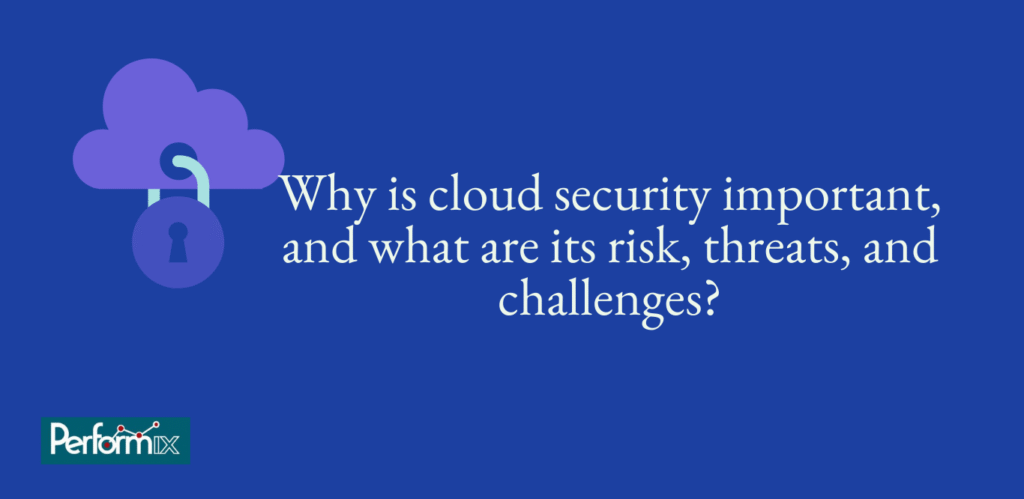Secure the Cloud
Organizational security is often overlooked during cloud migrations. As a result, the company is vulnerable to cloud-only risks and hazards that cannot be mitigated using on-premises solutions. When a company moves to the cloud, it needs to develop a comprehensive security plan for the cloud that works with the company’s larger enterprise security plan and solutions. Due to the unique nature of cloud computing, an amazing set of security design principles, processes, and technologies is essential to ensure the safety and privacy of data stored in the cloud.
Many businesses have put in place different security measures to protect their cloud infrastructure, but this can make it hard to see what’s going on and hard to build a solid defense.
Do you know
By 2026, it is expected that the global market for cloud security software will be worth about 37 billion U.S. dollars. North America is the largest market, while Asia-Pacific is the fastest-growing market.
The rapid increase in cloud adoption has necessitated improved cloud security solutions in recent years. Because of this, managed security service providers often work with security solution providers to make more mature products that meet their customers’ needs.
Why invest in cloud security now?
As cloud computing grows, more and more businesses are taking advantage of cloud services. Cloud computing lets companies outsource IT work to focus on marketing, sales, and customer service.
Here are the top reasons to justify your investment in cloud security.
- A business needs to have its security team, as it represents the company’s brand image and protects it from any hostile attacks or intrusions. You must have a security team to defend yourself from hackers and viruses.
- Human resources have a greater impact on security. For instance, you must employ security personnel outside normal business hours to keep your company’s website up-to-date with the newest features and enhancements. Without a dedicated team, it is nearly guaranteed that your company’s website will be hacked or stolen.
- Security is as vital as sales- a firm’s success depends on the product or service it gives its customers or users.
- Security is a crucial component of your customer relationship; ensuring your client’s data and offering them a comfortable service is mandatory in the digital world.
- Your company’s employees are the lifeblood of every business; you must also prioritize their safety.
- Security is crucial for any computer virus or malware protection, and so businesses that rely significantly on computers and computer systems must be aware of their security procedures to secure them.
Risks, Threats, and Challenges
Every day, all businesses encounter security risks, threats, and obstacles. Many believe these phrases indicate the same thing, yet their meanings are more subtle. Understanding their distinctions can help you safeguard your cloud assets more effectively.
What is the distinction between threats, hazards, and obstacles?
- A risk is a potential for data loss or vulnerability.
- A threat is a form of attack or opponent.
- The obstacles a company faces when adopting realistic cloud security are a challenge.
A robust program must decrease risk, defend against threats, and overcome obstacles for your corporation to use the cloud securely for expansion. A comprehensive cloud security plan addresses all three elements, ensuring no foundational weaknesses.
For better understanding, let’s consider each as a different perspective to examine cloud security.
Risks of Cloud Security
Eliminating risk is not possible, but it can be managed. If you know about common risks ahead of time, you will be better prepared to deal with them in your environment. Described here are the four cloud security risks.
Human Error
Gartner predicts that through 2025, 99.9% of cloud security breaches will be attributable to human error. Errors caused by humans are a continual danger while developing business apps. However, public cloud resource hosting exacerbates the risk.
As a result of the cloud’s ease of use, users may be utilizing APIs you need to be made aware of with the necessary restrictions, weakening your perimeter security. Manage human error by constructing robust controls that assist individuals in making the right judgments.
One final rule – don’t blame individuals for errors. The responsible party is the procedure. Create protocols and boundaries that aid people in doing the right thing. The act of pointing fingers does not improve the security of your firm.
Misconfiguration
As service providers offer more services over time, misconfigured cloud settings increase. Nowadays, businesses utilize multiple suppliers.
Providers’ default setups vary, and each service has unique implementations and quirks. Opponents will continue to use insecure settings until businesses learn how to protect their cloud services well.
Data Breaches
A data breach occurs when private information leaves your control without your knowledge or consent. Most attacks are aimed at data because it is the most valuable thing to attackers. Misconfiguration and the absence of runtime protection can render the cloud vulnerable to theft. The consequences of data breaches vary depending on the type of data stolen. On the dark web, thieves sell personally identifiable information (PII) and personal health information (PHI) to those looking to steal identities or send phishing emails.
Other sensitive information, like internal documents and emails, could be used to hurt a company’s stock price and reputation. No matter why someone steals data, breaches continue to be a big problem for businesses that use the cloud.
Unmanaged Attack Surface
An attack surface is your environment’s complete exposure. The implementation of microservices may result in an explosion of publicly accessible workloads. Every task increases the attack surface. With tight supervision, your infrastructure may be exposed in ways you know once an attack occurs.
In addition to obvious information leaks, the attack surface might also comprise subtle information leaks that lead to an attack.

Threats of Cloud Security
Any attempt to take advantage of danger in your cloud resources is a threat. The four prevalent threats to cloud security are as follows:
Zero-day Attacks
Zero-day attacks can hurt you if you keep using computers and software, even if hosted in another company’s data center. It targets unpatched vulnerabilities in widely used software and operating systems. Even if your cloud setting is impeccable, an attacker can use zero-day flaws to access the system.
Insider Threats
Cybersecurity threats that originate within an organization are known as “insider threats.” It typically originates from an insider, such as a current or former employee, who has access to the company’s network, sensitive data, and intellectual property (IP), as well as knowledge of business procedures, company policies, and other information that would assist them to carry out an assault.
Cyberattacks
A cyber attack is when cybercriminals, hackers, or other digital enemies try to get into a computer network or system to change, steal, destroy or expose data.
Malware, phishing, DoS and DDoS attacks, SQL injections, and IoT-based assaults are typical cyberattacks against companies.
Advanced Persistent Threats (APT)
An APT is a sophisticated, ongoing cyberattack in which an attacker stays hidden within a network for an extended period to steal important information.
APTs are not “drive-by” cyberattacks. The intruder stays put within the system, moving from one workload to the next in pursuit of valuable information. These attacks are dangerous because they might begin with a zero-day vulnerability and go undetected for months.

Challenges with Cloud Security
Difficulties arise whenever there is a failure to bridge the gap between theoretical understanding and actual application.
The following are the cloud security challenges every business encounters when embracing the cloud.
Lack of Cloud Security Planning and Capabilities
Traditional security models for data centers are unsuitable for the cloud. Cloud computing necessitates that administrators acquire new tactics and abilities.
While the cloud can provide organizations with agility, it can also expose them to risks if they lack the internal expertise and capabilities to understand cloud security concerns adequately. Planning might emerge as a misunderstanding of the consequences of the shared responsibility model, which outlines the cloud provider’s and user’s security responsibilities. This misunderstanding could result in the exploitation of unintended security vulnerabilities.
Shadow IT
Another significant problem in cloud settings is “shadow IT,” which refers to using IT resources (such as apps and infrastructure) outside the official purview of the company’s IT department. DevOps frequently contributes to this difficulty, as the barrier to entering and utilizing a cloud-based asset, such as a workload or a container, could be higher. Using their accounts, developers can quickly create new workloads. These unauthorized assets threaten the environment since they are frequently not properly secured and can be accessed using readily hacked default passwords and configurations.
Identity and Access Administration
IAM (Identity and Access Management) is crucial. Although this may seem clear, the difficulty is in the specifics. It takes work to set up the necessary roles and permissions for a business with thousands of employees. A full IAM strategy has three parts: designing functions, managing privileged access and implementing the plan. Start with a robust role design based on the requirements of cloud users. These roles reflect the consistent tasks that your workers perform across cloud providers. Design the functions independently of any particular IAM system. Next, a strategy for privileged access management (PAM) says which parts need extra security because of their privileges. Control access to privileged credentials strictly and rotate them often. The time has finally arrived to install the planned roles within the cloud provider’s IAM service. After constructing these beforehand, this phase will be considerably simpler.
Cloud Compliance
Organizations must maintain compliance with data security standards like PCI DSS and HIPAA. Credit card information and healthcare patient records are examples of sensitive data. To guarantee that compliance standards are fulfilled, many businesses restrict user access and the actions they can perform with access. Access control mechanisms must be implemented to ensure that monitoring network access becomes easy.
Establishing visibility and control is essential to managing a holistic, multi-cloud security operation. Organizations that use the cloud or are moving to the cloud should make a security plan that fits the needs of their cloud assets and put it into action. To create an innovative approach to your company’s culture and cloud security strategy, you must first take stock of your available resources and evaluate the specific demands of your firm.
Cloud Security is something that requires immediate attention from all organizations. If you are planning to migrate or have already migrated, it is sensitive to study and take measures to maintain a healthy cloud.
Get a trustworthy and secure cloud solution by partnering with a team of certified cloud professionals with a mission of constant innovation and mature solutions. Performix delivers real-time, unrestricted access to your cloud data and lessens the effects of cloud computing security threats.








